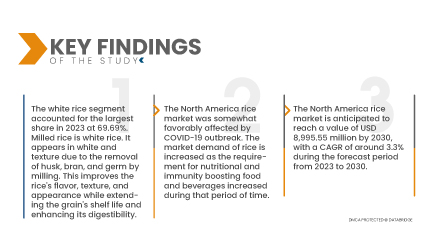Rice is a cereal grain that is one of the world's most commonly consumed staple foods. It belongs to the grass family known as Oryza sativa and is distinguished by its tiny, oval-shaped seeds, usually colored white, brown, or black. In many parts of the globe, especially in Asia, rice is a staple food and a rich source of carbohydrates. It can be used as a base for many dishes and can be prepared in several different methods, including boiling, steaming, or frying. There are numerous types of rice, each with a distinctive taste, flavor, and nutrient composition. White rice, brown rice, black rice, and other varieties are some popular varieties of rice. In addition, rice has many health benefits. It retains the bran layer and has beneficial elements like flavonoids that help treat cardiac conditions, gastric and pancreatic cancers, and type 2 diabetes. It is a grain devoid of gluten that benefits those with gluten sensitivity or coeliac disease. Since this industry is continuously emerging and evolving it contains a lot of potential and scope to be met in the forecast period.
Access Full Report @ https://www.databridgemarketresearch.com/reports/north-america-rice-market
Data Bridge Market Research analyses that the North America Rice Market is expected to grow at a CAGR of 3.3% from 2023 to 2030 and is expected to reach USD 8,995.55 million by 2030. Active collaboration, launches, and promotional efforts from the key market players are creating a new opportunity for the North America rice market to grow in the upcoming years.
Key Findings of the Study
Government initiatives to promote rice production
The governments have implemented various initiatives to promote rice production in the region. Governments may subsidize rice farmers to help offset the costs of inputs such as seeds, fertilizers, and pesticides. These subsidies can help encourage farmers to continue producing rice, even during low prices or poor weather conditions. Governments implement price support programs to help stabilize rice prices and ensure that farmers receive a fair price for their crops. These programs can be especially important in times of market volatility or when rice is oversupplied. Various extension services are also provided to help rice farmers learn about new technologies, production methods, and market opportunities. These services help farmers improve their yields, reduce costs, and increase their income.
The U.S. Department of Agriculture (USDA) has also implemented conservation programs to help rice farmers reduce their environmental footprint and improve their sustainability. These include the Conservation Reserve Program (CRP) and the Environmental Quality Incentives Program (EQIP). The USDA has also implemented price support programs to help stabilize rice prices and ensure that farmers receive a fair price for their crops. This includes programs such as the Marketing Assistance Loan Program (MAL) and the Price Loss Coverage (PLC) program. Thus, government initiatives to promote rice production can help support the livelihoods of rice farmers, ensure food security for populations and contribute to the overall economic development which will ultimately benefit North America rice market.
Report Scope and Market Segmentation
|
Report Metric
|
Details
|
|
Forecast Period
|
2023 to 2030
|
|
Base Year
|
2022
|
|
Historic Years
|
2021 (Customizable to 2020 - 2015)
|
|
Quantitative Units
|
Revenue in USD Million, Volumes in Units, Pricing in USD
|
|
Segments Covered
|
By Product Type, Brown Rice, White Rice, Black Rice, Red Rice), Rice Category (Basmati Rice, Jasmine Rice, Parboiled Rice, Wild Rice, and Others), Grain Size (Long Grain Rice, Medium Grain Rice, and Short Grain Rice), Nature (Organic and Conventional), End User (Household/Retail, Food Processing Industry, Flour Industry, Animal Feed, and Others)
|
|
Countries Covered
|
U.S., Canada, Mexico
|
|
Market Players Covered
|
Riceland Foods. (Arkansas, U.S), St. Maries Wild Rice & Ankeny Lakes Wild Rice Company (Salem, U.S), Doguet's Rice Milling Company (Texas, U.S), Supreme Rice, LLC (Louisiana, U.S.A.), Koda Farms, Inc. (California, U.S.A.), Martin Rice Company (Missouri, U.S.A.), SunWest Foods. (California, U.S.A.), Goya Foods, Inc. (New Jersey, U.S), LT Foods. (New Delhi, India), Robbins Rice Company (North California , U.S), Riviana Foods Inc. (Pennsylvania, U.S), Kohinoor Foods Ltd. (Delhi, India), KRBL (Uttar Pradesh, India), PLANETRICE (California, U.S.A.), and Willmill Rice Co. LLC(Arkansas, U.S.A.) among others.
|
|
Data Points Covered in the Report
|
In addition to the insights on market scenarios such as market value, growth rate, segmentation, geographical coverage, and major players, the market reports curated by the Data Bridge Market Research also include depth expert analysis, patient epidemiology, pipeline analysis, pricing analysis, and regulatory framework.
|
Segment Analysis:
North America rice market is segmented into six notable segments based on product type, rice category, grain size, nature, end user, and distribution channel.
- On the basis of product type, the North America rice market is segmented into brown rice, white rice, black rice, and red rice. In 2023, the white rice segment is expected to dominate the North America rice market with a 69.69% market share and is expected to reach USD 6,236.56 million by 2030, growing with the CAGR of 3.2% in the forecast period of 2023 to 2030.
In 2023, the white rice segment is expected to dominate the North America rice market.
In 2023, the white rice segment is expected to dominate the North America rice market due to it is an essential source of nutrition that contains manganese and vitamins. In addition, white rice is easy to digest and cook as well.
- On the basis of rice category, the North America rice market is segmented into parboiled rice, jasmine rice, basmati rice, wild rice, and others. In 2023, the basmati rice segment is expected to dominate the North America rice market with a 44.50% market share and is expected to reach USD 4,085.54 million by 2030, growing with a CAGR of 3.6% in the forecast period of 2023 to 2030.
- On the basis of grain size, the North America rice market is segmented into short grain rice, medium grain rice, and long grain rice. In 2023, the long grain segment is expected to dominate the North America rice market with a 73.84% market share and is expected to reach USD 6,607.20 million by 2030, growing with a CAGR of 3.2% in the forecast period of 2023 to 2030.
- On the basis of nature, the North America rice market is segmented into organic and conventional. In 2023, the conventional segment is expected to dominate the North America rice with an 88.98 % market share and is expected to reach USD 7,959.28 million by 2030, growing with a CAGR of 3.2% in the forecast period of 2023 to 2030.
- On the basis of end user, the North America rice market is segmented into household/retail, food processing industry, flour industry, animal feed, and others. In 2023, the household/retail segment is expected to dominate the global North America rice market with a 54.06% market share and is expected to reach USD 4,891.21 million by 2030, growing with a CAGR of 3.4% in the forecast period of 2023 to 2030.
- On the basis of distribution channel, the North America rice market is segmented into direct and indirect. In 2023, the direct segment is expected to dominate the North America rice market with a 58.26% market share and is expected to reach USD 5,293.99 million by 2030, growing with a CAGR of 3.5% in the forecast period of 2023 to 2030.
- On the basis of geography, the North America rice market is segmented into major countries such as the U.S., Canada, and Mexico. In 2023, the U.S. is expected to dominate the North America rice market with a 78.63% market share and is expected to reach USD 7,099.40 million by 2030, growing with a CAGR of 3.4% in the forecast period of 2023 to 2030.
Major Players
Data Bridge Market Research recognizes the following companies as the major North America rice market players in North America rice market are Riceland Foods., St. Maries Wild Rice & Ankeny Lakes Wild Rice Company, Doguet's Rice Milling Company, Supreme Rice, LLC, Koda Farms, Inc., Martin Rice Company, SunWest Foods., Goya Foods, Inc., LT Foods., Robbins Rice Company, Riviana Foods Inc., Kohinoor Foods Ltd., KRBL, PLANETRICE, and Willmill Rice Co. LLC among others.
Market Development
- In January 2023, according to adgully, KRBL announced the launch of its new campaign, "Basmati Rice Se No Compromise," in 2023. With this campaign, India Gate is unmistakably acting as a category captain, encouraging consumers to choose packaged basmati over khulla (loose) basmati. This campaign will help consumers to focus their attention on the company.
- In March 2022, LT Foods announced the acquisition of 51% in Golden Star Trading Inc. along with its brand Golden Star Via its subsidiary LT Foods America In. This acquisition has helped the company to expand more.
- In June, Riceland Foods has unveiled a new partnership with Arva Intelligence as the cooperative shifts its sustainability emphasis to capturing agronomic and economic data related to its farmer members' crop production. For its farmer partners, Riceland is committed to generating value through sustainability through the Ingrain Good Sustainability Initiative.
- In September, Willmill Rice Co. LLC. along with other market players of Arkansas rice industry, donated rice to the Arkansas Foodbank. This kind of participation in donation events has helped the company to gain the attention of consumers as well as to keep competitive among the competitors.
Regional Analysis
In 2023, the U.S. is expected to dominate the North America rice market with a 78.63% market share and is expected to reach USD 7,099.40 million by 2030. U.S. might have the fastest growing CAGR of 3.4% in the forecast period of 2023 to 2030 due to the increasing demand of various rice and the advertisement campaigns conducted by the major market players.
COVID-19 Impact Analysis
Considering the significant declines in numerous industries, the government, business leaders, and consumers must work together to defeat COVID-19. In this situation, impact of the COVID-19 pandemic on the North American market of rice is somewhat beneficial. Governments all across the world closely adhere to the general public health measures, which include raising awareness about obesity and nutritional value-added food and beverages. North American government was no exception. Consumer knowledge of high immunity has become a legitimate worry during the pandemic. Customers are increasingly making their purchases healthier rather than tastier food. In this scenario, rice grains, especially whole grains, were enhanced in consumer usage due to its benefits. Another reason for the market blooming in the pandemic era is its versatility. For instance, different flavors, origins, categories, and nature are available in the market. Moreover, in this post-pandemic era, the situation has been better due to increased consumer demand, shifting towards healthy and energy-providing plant-based products than other unhealthy products.
For more detailed information about the North America rice market report, click here – https://www.databridgemarketresearch.com/reports/north-america-rice-market












